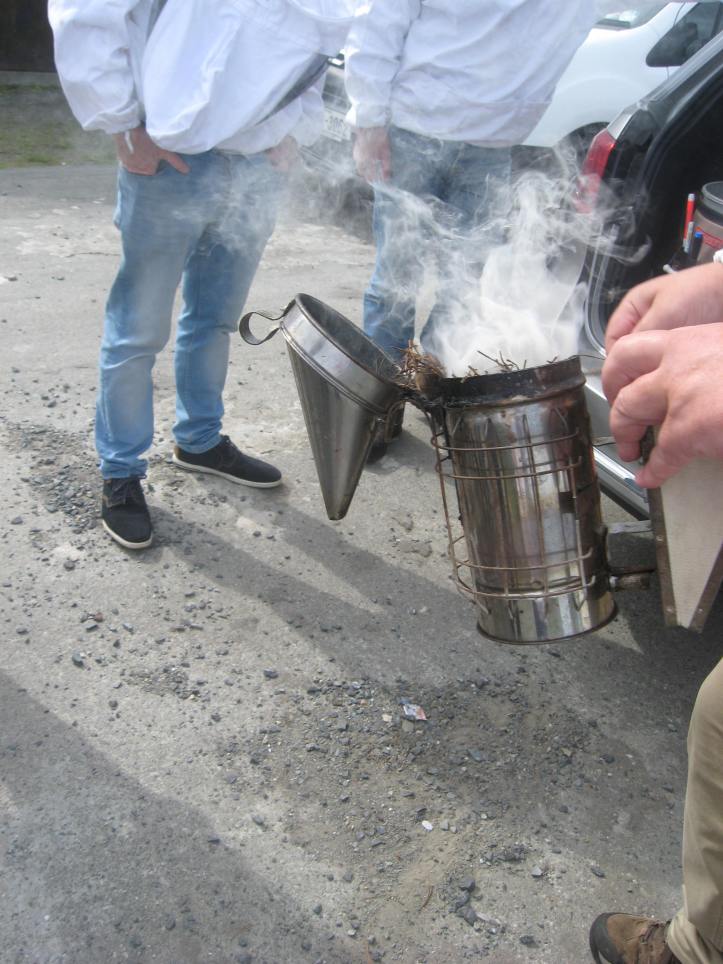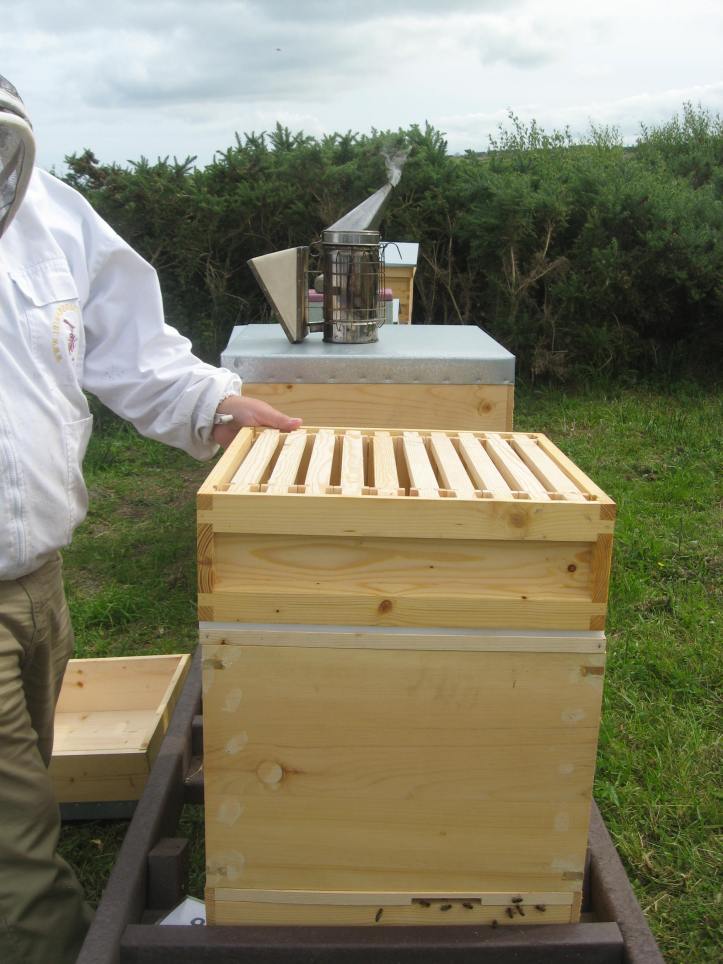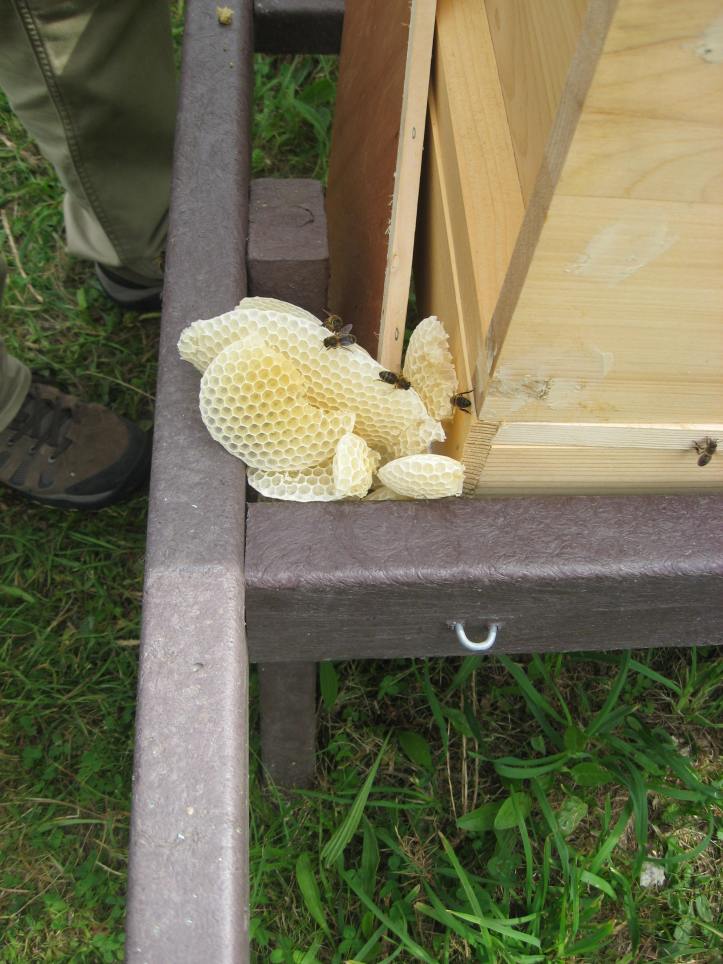My beekeeping studies continue – this post follows on from An Inspiring Introduction to Beekeeping
A big thank you to my teachers at The Glasshouses, Killult http://www.natithegloine.com
Smokers
Smoke is puffed over the top of the frames, to calm the bee colony when inspecting a hive.
Scraps of newspaper are first set on fire inside a metal container in the smoker, before adding pine needles to create smoke for the inspection.
The smoke is then dispensed using the small bellows attached to the main metal container.

Hive Inspection
The roof of the hive is removed gently to allow for close inspection, before smoke is puffed over the top of the frames.
You will see that these outer frames are beginning to get covered in wax comb by the bees. You can also see small residues on the inside cover.
As the inspection continued we witnessed lots of activity on the more central frames. The combs here are also getting heavy with honey, Drone and Worker bee larva, pollen and excess comb.
The Queen was located near the centre of the hive, where the worker bees are keeping her healthy by feeding her royal jelly.
Adding a Super
This hive contained eight frames of larvae, thus it was deemed to be in good health, and a new box of frames or super, was added on top of the bottom layer containing the brood colony to:
- give the colony more space
- to store more honey.

Adding a Queen Excluder
A thin divider made of white plastic mesh called a Queen Excluder is placed between the brood colony, and the new super.
The mesh allows the main colony to move freely between layers of the hive, but the Queen will remain with her brood colony, creating new generations of bees.
Harvesting Honey
Beekeepers never take honey from the brood colony, only from the supers. Several layers of supers can be added when honey production is at its peak in summer.
Did you know that a healthy bee colony will produce 60 – 100 pounds of honey in a year?
I bought a lovely jar of local honey to sample, and it was delicious!
Beeswax Comb
Any excess comb on the frames is removed with a hive tool, and can be used to make candles, ointments…

Classes have ended for this year, but I shall include one more post next month, before follow ups next spring.
Brigid P. Gallagher is a retired natural medicines therapist, passionate organic gardener and author of “Watching the Daisies- Life lessons on the Importance of Slow,” a holistic memoir dedicated to the art of mindfulness and healing from debilitating illness.


Wow awesome presentation of a great study of bees that you are doing, Brigid. So nice to be learning new and new things in life. Thanks so much for your wonderful share.
LikeLiked by 4 people
I am glad to share Kamal. I hope to get my own hives next spring. Meanwhile, I am learning as much as I can…
LikeLiked by 1 person
Wow that is awesome, Brigid and it will so nice to get one of your own.
LikeLiked by 1 person
Super! I like this. We have been dreaming ourselves of having own bees. Much to learn though…so much to learn!
LikeLiked by 1 person
Thank you. I agree there is tons to learn. The course I am doing has great mentors who are available for support when we are ready to get our own hives. Hopefully, next spring.
LikeLike
All so informative and a well-done post, Brigid.
LikeLiked by 1 person
Thank you Jennifer. I hope to have my own hive from next spring.
LikeLiked by 1 person
This is wonderful. Myself and partner went on an introductory bee keeping course last weekend in Devon and it was so interesting. I think we’ll be taking other courses 🙂
LikeLiked by 1 person
Great to know others are getting the joy of beekeeping. Best wishes for your journey.
LikeLiked by 1 person
Thank you, and likewise, best wishes for your bee journey too 🐝 😊
LikeLiked by 1 person
So glad you continued with this – I always wondered how honey was extracted from the combs you find for craft use (ie-candles and such). Now it makes sense…excess combs!
LikeLiked by 1 person
Thank you Laura. I have one other beekeeping post planned this autumn, but I shall continue on in Spring. Hoping to get my own hive around April.
LikeLiked by 1 person
That sounds exciting!
LikeLiked by 1 person
My sister just collected all of her honey from her bees. She had a few problems this year and she said these bees were more vicious than last years–would chase her around the yard! But, she loves her honey, and so do I.
LikeLiked by 1 person
I heard stories of vicious bees from other beekeepers. It seems some nastier bees can evolve and enjoy chasing humans. I hope your sister’s bees settle down. I agree though, the honey is well worth the angst.
LikeLike
I am learning so much from this post. So much talk about the bees. Yet, your post brings the lessons to life, in a whole new way. Thank you Brigid!
LikeLiked by 1 person
Thank you Andrea. My learning continues, and I hope to have my own hive next spring. I am enjoying tasting different honeys at the moment. Heather honey is ahead at the moment.
LikeLiked by 1 person
Brigid, this is so fasinating and thank you for sharing.
LikeLiked by 1 person
Thank you Karen. I find bees very intriguing, and just love learning more about their characteristics and life cycle.
LikeLiked by 1 person
Brigid, I do too. I watch them from my porch everyday as the pollenate my Vox Lilac. 🙂
LikeLiked by 1 person
I kept bees for many years, following on from my grandfather. It is a very rewarding hobby.
LikeLiked by 1 person
Wonderful. I am hoping to have my own hive next spring Brian.
LikeLiked by 1 person
Wow so much to know about bees, quite complicated. Learnt a lot.
I like the way you laid out your post.
LikeLiked by 1 person
I so want a hive- thank you for sharing what you are learning! 😀
LikeLiked by 1 person
I want one too. Hoping to have my wish come true next spring.
LikeLike
So interesting, bees are so amazing. I’m not sure if I mentioned this to you before, but a few years ago I read Song of Increase the author is a bee keeper and here is a part of the description “Within these pages is a bee-centric approach to living with honeybees, rather than advice for simply maximizing the products they provide. Jacqueline Freeman takes us beyond traditional beekeeping and offers a way to work in harmony with honeybees for both their good and ours.”
I thought you would be interested in this book. Thank you
LikeLiked by 1 person
Thank you so much Masha. I really want to help the bees as much as possible, and still enjoy some honey. I will check this book out.
LikeLiked by 1 person
Thank you for the share, Bees are vital to our eco-system.
LikeLiked by 1 person
They are indeed. I so hope that mankind wakes up to their importance.
LikeLiked by 1 person
So do I.
LikeLiked by 1 person
Fascinating Brigid and thank you for sharing your latest adventure.. bees need all the help they can get these days.. xx
LikeLiked by 1 person
They sure do Sally. I hope to get my own hive in the spring. xx
LikeLiked by 1 person
[…] Head over to read the rest of this interesting post: https://watchingthedaisies.com/2019/09/11/an-inspiring-introduction-to-beekeeping-part-2/ […]
LikeLiked by 1 person
Fascinating, Brigid…I look forward to the next instalment what a lovely safe place your garden will be for the bees when you get your hive 🙂 x
LikeLiked by 1 person
There is such a lot to learn. I find bees fascinating. x
LikeLike
Oh, this does look like an interesting thing to do, Brigid. I wish I wasn’t so allergic.
LikeLiked by 1 person
It certainly is Robbie. Sadly, some of the beekeepers that I met became allergic too, sometimes after many years of beekeeping.
LikeLiked by 1 person
You get a worse reaction each time you are stung. I now react within minutes and it used to take much longer.
LikeLiked by 1 person
This was so interesting Brigid. I admire your following your passions and taking this course. ❤
LikeLiked by 1 person
Thank you Debby. I am really enjoying it.
LikeLiked by 1 person
This was cool! Thank you for the information! Have a blessed day!
LikeLiked by 1 person
Thank you. My learning journey continues…
LikeLike
Very cool Brigid, I didn’t realize you were doing bees as well. Did you do anything more with them this year? I have a couple of Warré hives. Had been wanting to beekeep for around 20 years… finally happened & it’s very enjoyable.
LikeLiked by 1 person
Thank you Mike. Unfortunately, bees are on hold at the moment. Hopefully, next year. They are indeed very enjoyable and fascinating.
LikeLiked by 1 person